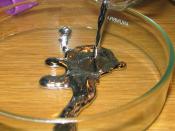What Is Mercury?
As anyone who's ever broken a thermometer can attest, mercury is a very fascinating substance. It also has an interesting history. Named after the fleet-footed Roman messenger of the gods, mercury has been used for more than 2,000 years. Mercury ore cinnabar has even been found smeared on Neolithic (stone age) skulls. Its first recorded mention is a reference by Aristotle in the fourth century B.C., a time when the silvery-white, heavy metal was used in religious ceremonies. Spanish miners used mercury to process gold ore for ancient Rome; when their mercury supply ran out, gold production dropped and set in motion the decline of the Roman Empire. Today mercury poses a serious threat, this time environmental. Human beings around the world cause mercury to enter the atmosphere primarily when they burn coal or incinerate waste. Studies from Sweden and Florida suggest that mercury also evaporates from landfills, but only 0.0001
per cent. Groundwater contamination from old dumps is of concern but combustion is the major path via which mercury pollutes the globe. Mercury rarely exists in a free state in nature; it's been recovered in geologically recent volcanic rocks. The world inventory of mined mercury is estimated at 600,000 tons, stored mostly in states of the former Soviet Union. Scientists estimate that man-made mercury releases are two to four times greater than those of nature. The typical mercury content of lakes has increased up to sevenfold since industrialization. Acid rain dissolves lake-rock and releases mercury to water. With a melting point of minus 38.87ðC, metallic or elemental mercury (the form used in thermometers) readily vaporizes and can be transported long distances. The vaporization rate of mercury doubles with every 10ðC temperature increase and its residence time in the atmosphere is up to three years. Not...


